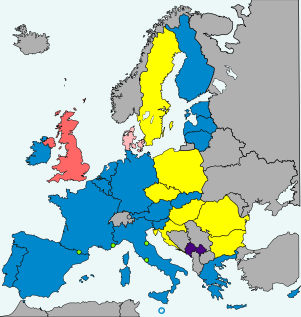Swedish euro referendum, 2003

-
<dt class="glossary " id="European Union (EU) member states" style="margin-top: 0.4em;">European Union (EU) member states
- Non-EU member states
A non-binding referendum on introduction of the euro was held in Sweden on 14 September 2003.[1] The majority voted not to adopt the euro, and thus Sweden decided in 2003 not to adopt the euro for the time being. Had they voted in favor, the plan was that Sweden would have adopted the euro on 1 January 2006.[2]
The ballot text was "Do you think that Sweden should introduce the euro as currency?" (Swedish: "Anser du att Sverige skall införa euron som valuta?"). Sweden in Europe was the main umbrella group campaigning for a Yes vote. The No vote campaign was led by two organisations, representing left (Folkrörelsen Nej till EU) and right wing politicians respectively. The political parties were divided. Some supported introducing the euro, some were against, and the Social Democrats did not take a position due to internal disagreements.
Background
Sweden joined the European Union in 1995 and its accession treaty has since obliged it to join the euro. However, one of the requirements for eurozone membership is two years' membership of ERM II, and Sweden has chosen not to join this mechanism and as a consequence tie its exchange rate to the euro ±2.25%. While there is government support for membership, all parties have pledged not to join without a referendum in favor of doing so.
Result
The voter turnout was 82.6%, and the result was 55.9% against and 42.0% in favor.[1] A majority of voters in Stockholm county voted in favor of adopting the euro (54.7% "yes", 43.2% "no"). In Skåne and Stockholm counties the "yes" votes (49.3%) outnumbered the "no" votes (48.5%), although the invalid and blank votes resulted in no majority for either option. In all other parts of Sweden, the majority voted no.[3][4] Among municipalities, a majority of those in western Skåne, and in Stockholm county, voted yes. Kungsbacka and Haparanda also voted "yes". Haparanda is the only city in Sweden bordering the eurozone. All other municipalities voted "no".
| Summary of the referendum |
Votes | Percent |
|---|---|---|
| Yes | 2,453,899 | 42.0 |
| No | 3,265,341 | 55.9 |
| Blank votes | 121,073 | 2.1 |
| Total | 5,840,313 | 100 |
| Invalid votes | 3,475 | |
| Eligible voters | 7,077,502 | |
| Turnout | 5,843,788 | 82.6 |
Source: Nationalencyklopedin[5]
See also: Swedish Election Authority[6]
See also
Notes
- ↑ Kosovo is the subject of a territorial dispute between the Republic of Kosovo and the Republic of Serbia. The Republic of Kosovo unilaterally declared independence on 17 February 2008, but Serbia continues to claim it as part of its own sovereign territory. The two governments began to normalise relations in 2013, as part of the Brussels Agreement. Kosovo has received recognition as an independent state from 110 out of 193 United Nations member states.
References
- 1 2 "Folkomröstningar 1922-2003" (in Swedish). Statistics Sweden. 21 December 2007. Archived from the original on 22 May 2011. Retrieved 22 May 2011.
- ↑ "Heikensten: The Riksbank and the euro". Sveriges Riksbank. 2003-06-17. Retrieved 26 December 2008.
- ↑ "Sweden. Euro Referendum 2003". Electoral Geography. Retrieved 26 December 2008.
- ↑ "Riksöversikten" (in Swedish). Valmyndigheten. Retrieved 17 May 2009.
- ↑ "Folkomröstning: Tabell: Folkomröstningar i Sverige". Nationalencyklopedin (in Swedish). Retrieved 22 May 2011. (subscription required)
- ↑ "Nationella folkomröstningar" (in Swedish). Swedish Election Authority. Archived from the original on 22 May 2011. Retrieved 22 May 2011.